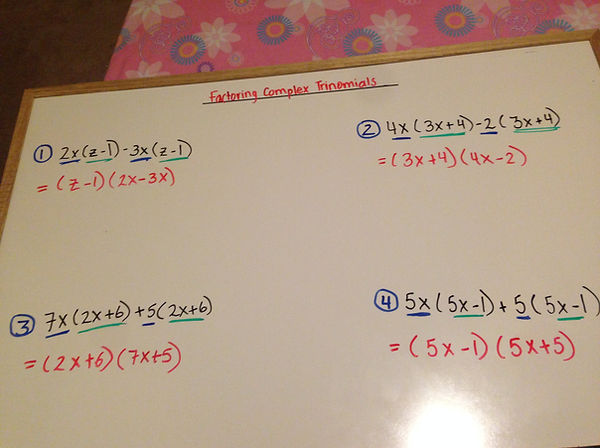
Quadratic RELATIONS

Factoring Simple Trinomials: x2+bx+c
Many polynomials such as 5x2+2x+1 can be written as the product of two binomials of the form (x+r) and (x+s)
Keep in mind, when factoring a polynomial of the form ax2+bx+c(when a=1), we want to find the following..
1) Two numbers that ADD to give b *Also referred as product and sum*
2) Two numbers that MULTIPLY to give c
To help you understand this concept more clearly, use product and sum.
For example: x2+5x(Sum)+6(Product) _3_ x _2_ = 6
=(x+3)(x+2) _3_ + _2_ = 5
*Note if the product and sum do not equal to each other, its known as 'not possible'
For example: x2+2x+7
-Therefore, not possible
Now lets practice:
1) x2-29x+28 2) x2+6x+5
3) x2-52x+100 4) x2-10x+8
Answers:
Factoring Complex Trinomials a≠1
Complex Trinomials have a coefficient besides than 1 in front of the x2 term
Before we can solve a Complex Trinomial, we have to learn the concept of the following;
1) Binomial common factoring
2) Factor by Grouping
Binomial common factoring:
Example 1: 3x(2x-3)-2(2x-3)
= (2x-3)(3x-2) < Basically here we collected the like terms which were(2x-3) and put brackets on the left over variables which were (3x-2)
Now lets practice:
1) 2x(z-1)+3x(z-1) 2) 4x(3x+4)-2(3x+4)
3) 7x(2x-6)+5(2x-6) 4) 5x(5x-1)+5(5x-1)
Answers:
Factoring by grouping:
Example 1: (ef+dg) (eg+df) [ There is no common factor amongest each brackets]
*However we can group the variables that have a common factor*
= (ef+df)(eg+dg) [Now we can common factor]
= f(e+d)+g(e+d)
[Now we use Binomial common factoring]
= (e+d)(f+g)
For solving a complex trinomial we can solve it with two methods:
1) Decomposition Method
2) Trial and Error
Decomposition Method: Trial and Error:
Now lets practice ( Preferred Decomposition)
1) 5x2-14x+8 2) 10y2-9x+2
3) 16x2+26x+12 [Always remember to common factor]

